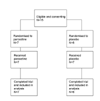Quality of life and metabolic status in mildly depressed women with type 2 diabetes treated with paroxetine: a single-blind randomised placebo controlled trial
- PMID: 12747810
- PMCID: PMC165418
- DOI: 10.1186/1471-2296-4-7
Quality of life and metabolic status in mildly depressed women with type 2 diabetes treated with paroxetine: a single-blind randomised placebo controlled trial
Abstract
Background: Depression is prevalent in people with type 2 diabetes and affects both glycemic control and overall quality of life. The aim of this trial was to evaluate the effect of the antidepressant paroxetine on metabolic control, quality of life and mental well-being in mildly depressed women with type 2 diabetes.
Methods: We randomised 15 mildly depressed women with non-optimally controlled type 2 diabetes to a 10-week single-blind treatment with either paroxetine 20 mg per day or placebo. Primary efficacy measurements were glycemic control and quality of life. Glycosylated hemoglobin A1c (GHbA1c) was used as a measure of glycemic control. Quality of life was evaluated using RAND-36. Mental state was assessed using two clinician-rated scoring instruments, Hamilton's Anxiety Scale (HAM-A) and Montgomery-Asberg's Depression Rating Scale (MADRS), and a patient-rated scoring instrument, Beck's Depression Inventory (BDI).
Results: At the end of the study no significant difference between groups in improvement of quality of life was found. A trend towards a superior improvement in glycemic control was found in the paroxetine group (p = 0.08). A superior increase in sex-hormone-binding-globuline (SHBG) levels was evidenced in the paroxetine group (p = 0.01) as a sign of improved insulin sensitivity. There was also a trend for superior efficacy of paroxetine in investigator-rated anxiety and depression. This notion was supported by a trend for superior decrease of serum cortisol levels in the paroxetine group (p = 0.06).
Conclusion: Paroxetine has a beneficial effect on measures of insulin sensitivity and may improve glycemic control. Larger studies of longer duration are needed to verify the benefits of paroxetine in type 2 diabetes. While waiting for more conclusive evidence it seems sensible to augment standard care of type 2 diabetes with paroxetine even in patients who do not fulfil routine psychiatric criteria for initiation of antidepressant drug treatment.
References
-
- Harris MI, Flegal KM, Cowie CC, Eberhardt MS, Goldstein DE, Little RR, Wiedmeyer HM, Byrd-Holt DD. Prevalence of diabetes, impaired fasting glucose, and impaired glucose tolerance in US adults: the Third National Health and Nutrition Examination Survey, 1988–94. Diabetes Care. 1998;21:518–524. - PubMed
-
- Nelson RG, Everhart JE, Knowler WC, Bennett PH. Incidence, prevalence, and risk factors for non-insulin dependent diabetes mellitus. Primary Care. 1988;15:227–250. - PubMed
-
- Golay A, Felber JP, Dusmet M, Gomez F, Curchod B, Jequier E. Effect of weight loss on glucose disposal in obese and obese diabetic patients. Int J Obes. 1985;9:181–190. - PubMed
-
- O'Kane M, Wiles PG, Wales JK. Fluoxetine in the treatment of obese type 2 diabetic patients. Diabetic Med. 1994;11:105–110. - PubMed
-
- Gray DS, Fujioka K, Devine W, Bray GA. A randomized double-blind clinical trial of fluoxetine in obese diabetics. Int J Obes Relat Metab Disord. 1992;16:S67–S72. - PubMed
Publication types
MeSH terms
Substances
LinkOut - more resources
Full Text Sources
Other Literature Sources
Medical
Miscellaneous


